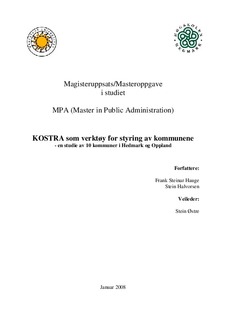| dc.description.abstract | The Norwegian public sector, in particular local Councils as the principal supplier of welfare
services, face great challenges in the coming years. Expectations and demands upon public
services are increasing in proportion with the increase in private wealth. Among the
consequences are higher demands on the distribution of welfare services, and the need for a
more effective use of resources.
Inspired by New Public Management theories, Norwegian local Councils have made
considerable changes in management over the last 10-20 years. To meet the demands for
increased activity, public sector has undergone a transition towards a less hierarchal
organisational structure, their delegation to appropriate performance units has increased, and
systems to monitor aims and results have been introduced. With respect to the latter, it has
become crucial that data concerning resource utilisation and economy are made easily
available and can be related to management issues.
In 2001 the national government introduced the so-called KOSTRA public reporting system
(Kommune-ST-at-Rapportering) The overall aim of KOSTRA is to produce relevant, reliable,
current and comparable management information. In addition, the KOSTRA reporting system
will provide an improved database as an aid to service provision, as well as providing a
foundation for improved Council management.
Our aim with this assignment has been to take a closer look at KOSTRA as a suitable tool for
resource management within local Councils, and to see whether Councils do in fact use it
actively in their own administrational priorities and activities. We have illustrated this by
taking a closer look at possible connections between active use of KOSTRA and the
Councils` economic situation, priorities and effectiveness.
We have found no grounds in our studies to indicate that there is any difference in the
allocation of priorities between those local Councils using KOSTRA in management-related
activities and those who do not. On the other hand, we have discovered links between active
use of KOSTRA and the Councils`economic situation. This connection is very interesting. It is the Councils under financial stress which appear to be
using KOSTRA actively.
Our major conclusion is that KOSTRA alone does not produce all necessary and relevant
management information. KOSTRA is more applicable when seen in context with the
complexity of public sector, and with a firm knowledge of the system's underlying indicators. | en |
